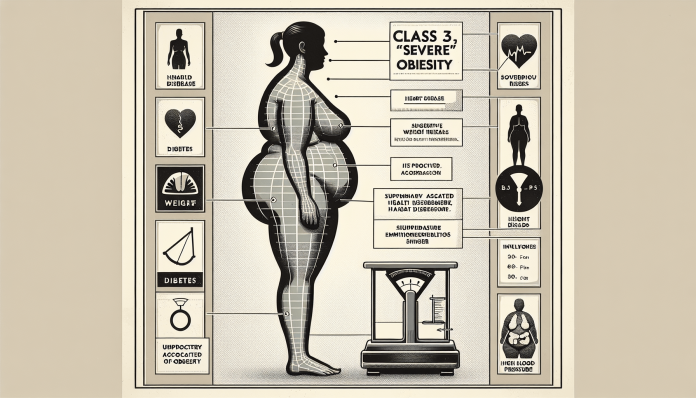
🏥 Understanding Class 3 Obesity
Class 3 obesity, also known as severe or morbid obesity, is a complex and challenging health condition that significantly impacts an individual’s physical, emotional, and social well-being. This article will delve into the intricacies of Class 3 obesity, exploring its causes, symptoms, health implications, and management strategies.
⚖️ Defining Class 3 Obesity
📊 BMI and Class 3 Obesity
Class 3 obesity is defined by a Body Mass Index (BMI) of 40 or higher. BMI is a measure of body fat based on height and weight. While it is not a perfect indicator, it provides a useful guideline for identifying obesity levels.
📉 Understanding BMI
🔢 BMI Calculation
BMI is calculated using the formula: BMI = weight (kg) / height (m²). For instance, an individual weighing 125 kg with a height of 1.7 meters would have a BMI of approximately 43.3, falling into the category of Class 3 obesity.
🔬 Causes of Class 3 Obesity
🌍 Multiple Factors
Class 3 obesity is typically the result of multiple factors, including genetics, lifestyle choices, and environmental influences. Understanding these factors is crucial for effective prevention and management.
🧬 Genetic Predisposition
🧬 Family History
Genetics play a significant role in the development of obesity. Individuals with a family history of obesity are more likely to struggle with weight issues themselves. Specific genes can influence how the body stores and processes fat.
🍔 Lifestyle Choices
🍔 Diet and Activity Levels
Poor dietary habits, such as consuming high-calorie, low-nutrient foods, and a sedentary lifestyle contribute significantly to weight gain. A lack of physical activity means fewer calories are burned, leading to weight accumulation.
🌐 Environmental Factors
🏙️ Socioeconomic and Cultural Influences
Environmental factors, including socioeconomic status and cultural norms, can affect an individual’s risk of developing obesity. Access to healthy foods and opportunities for physical activity are often limited in lower-income communities.
🩺 Health Implications of Class 3 Obesity
❤️ Physical Health Risks
Class 3 obesity is associated with numerous health risks, making it a serious medical condition that requires attention and intervention.
🫀 Cardiovascular Diseases
🫀 Heart Disease and Stroke
Individuals with Class 3 obesity are at a higher risk of developing cardiovascular diseases, including heart disease and stroke. Excess body fat can lead to high blood pressure, high cholesterol, and other conditions that strain the heart.
🌾 Diabetes
🌾 Type 2 Diabetes
There is a strong correlation between obesity and type 2 diabetes. Excess body fat, particularly around the abdomen, increases the body’s resistance to insulin, leading to higher blood sugar levels.
🦴 Musculoskeletal Problems
🦴 Joint Issues
Carrying excess weight puts additional stress on the joints, particularly in the knees and hips. This can lead to osteoarthritis and other musculoskeletal problems, causing pain and mobility issues.
🫁 Respiratory Issues
🫁 Sleep Apnea
Obesity is a significant risk factor for obstructive sleep apnea, a condition where the airway becomes blocked during sleep, leading to interrupted breathing and poor sleep quality. This condition can exacerbate other health issues and significantly impact the quality of life.
🧠 Mental Health
🧠 Psychological Impact
Class 3 obesity can have profound effects on mental health. Individuals may experience low self-esteem, depression, anxiety, and social isolation due to societal stigma and personal struggles with their weight.
📉 Managing Class 3 Obesity
🔄 Comprehensive Approach
Effective management of Class 3 obesity requires a multifaceted approach, including lifestyle changes, medical interventions, and psychological support.
🍎 Diet and Nutrition
🥗 Healthy Eating Habits
Adopting a balanced, nutrient-rich diet is crucial for weight management. This involves reducing calorie intake, choosing whole foods over processed ones, and paying attention to portion sizes. Consulting a registered dietitian can provide personalized guidance.
🏋️ Physical Activity
🏃 Exercise Routines
Regular physical activity is essential for weight loss and overall health. Incorporating both aerobic exercises (like walking, cycling, and swimming) and strength training can help burn calories and build muscle mass. It is important to start slowly and gradually increase the intensity of workouts.
💊 Medical Interventions
💊 Medication and Surgery
In some cases, medical interventions may be necessary. Weight-loss medications can help reduce appetite or increase feelings of fullness. For individuals with severe obesity, bariatric surgery may be an option. Procedures such as gastric bypass or sleeve gastrectomy can significantly reduce the capacity of the stomach and alter hormone levels to promote weight loss.
🧘 Psychological Support
🧠 Mental Health Counseling
Addressing the psychological aspects of obesity is crucial. Behavioral therapy, counseling, and support groups can help individuals develop healthier relationships with food, cope with emotional eating, and build self-esteem. Cognitive-behavioral therapy (CBT) is particularly effective in helping individuals change negative thought patterns and behaviors related to eating and body image.
🏥 Regular Health Check-Ups
🩺 Monitoring Health
Regular check-ups with healthcare providers are essential for monitoring progress and addressing any health issues that may arise. These visits can help track weight loss, manage comorbid conditions, and make necessary adjustments to the treatment plan.
🏠 Living with Class 3 Obesity
🧩 Day-to-Day Challenges
Living with Class 3 obesity involves navigating various challenges, from physical limitations to social stigmatization. Understanding these challenges and developing strategies to cope can improve quality of life.
🪑 Mobility and Accessibility
🪑 Physical Adaptations
Individuals with severe obesity may face difficulties with mobility and daily activities. Adapting living spaces to be more accessible, using mobility aids, and seeking physical therapy can help manage these challenges.

🤝 Social Support
🤝 Building a Support Network
Having a strong support network is crucial for managing obesity. Family, friends, and support groups can provide encouragement, share experiences, and offer practical help. Online communities and forums can also be valuable sources of support and information.
🎯 Setting Realistic Goals
🎯 Goal Setting and Persistence
Setting realistic, achievable goals is important for long-term success. Celebrating small victories and staying persistent, even in the face of setbacks, can help maintain motivation and foster a positive outlook.
🌐 The Role of Society
🔗 Addressing Societal Factors
Addressing Class 3 obesity also requires societal changes. Efforts to reduce the prevalence of obesity should include promoting healthier food options, creating opportunities for physical activity, and reducing the stigma associated with obesity.
🏫 Public Health Initiatives
🏫 Community Programs
Public health initiatives aimed at promoting healthy lifestyles can make a significant difference. Community programs that provide access to nutritious foods, safe places for exercise, and educational resources on health and wellness are vital.
📚 Education and Awareness
📚 Spreading Knowledge
Education campaigns that raise awareness about the causes and consequences of obesity can help reduce stigma and encourage healthy behaviors. Schools, workplaces, and media outlets play crucial roles in disseminating this information.
🏛️ Policy and Regulation
🏛️ Government Action
Government policies and regulations can support obesity prevention and treatment efforts. This includes implementing taxes on sugary drinks, regulating food advertising, and ensuring that healthcare systems are equipped to address obesity comprehensively.
🔍 Conclusion
🧠 Understanding and Addressing Class 3 Obesity
Class 3 obesity is a serious and complex health condition that requires a comprehensive approach for effective management. By understanding its causes, health implications, and management strategies, individuals and society can work together to address this growing public health issue. Support from healthcare providers, family, and community resources plays a crucial role in helping individuals with Class 3 obesity lead healthier, more fulfilling lives.



















